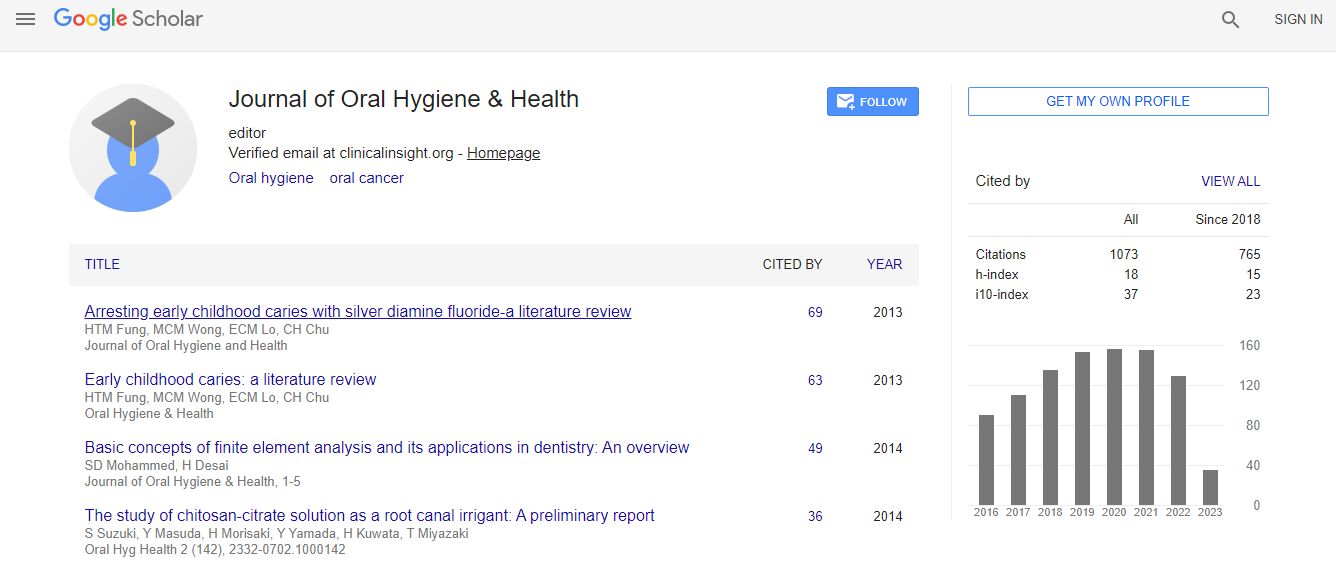Our Group organises 3000+ Global Conferenceseries Events every year across USA, Europe & Asia with support from 1000 more scientific Societies and Publishes 700+ Open Access Journals which contains over 50000 eminent personalities, reputed scientists as editorial board members.
Open Access Journals gaining more Readers and Citations
700 Journals and 15,000,000 Readers Each Journal is getting 25,000+ Readers
Google Scholar citation report
Citations : 1073
Journal of Oral Hygiene & Health received 1073 citations as per Google Scholar report
Journal of Oral Hygiene & Health peer review process verified at publons
Indexed In
- Index Copernicus
- Google Scholar
- Open J Gate
- JournalTOCs
- RefSeek
- Hamdard University
- EBSCO A-Z
- OCLC- WorldCat
- Publons
- Geneva Foundation for Medical Education and Research
- Euro Pub
- ICMJE
Useful Links
Recommended Journals
Related Subjects
Share This Page
The comparative study of five different calcium hydroxide residues in root canal after final canal preparation using ProTaper rotary system and NaOCl 2.5%
13th International Conference and Exhibition on Dental Medicine
Sogol Amiri
Iran
Posters & Accepted Abstracts: J Oral Hyg Health
Abstract
Introduction: There is a high possibility that intracanal medication used for multiple-visit treatment, remains in root canal even after incorporating different endodontic instruments and chemical substances for removing it, prior to obturation. Aims: Our study aims to evaluate the residues of five different calcium hydroxides which are presumed to be eliminated completely after final root canal preparation with ProTaper rotary files and NaOCl 2.5%, in identically prepared single-rooted teeth, using stereomicroscope. Material & Methods: 81 single-rooted straight and intact human teeth, consisting of 17 maxillary central incisors, 17 maxillary canines and 47 maxillary premolars, were decrownated from 15 mm to anatomic apex and randomly divided into 5 groups of each with 3 incisors, 3 canines and 9 premolars. 5 positive and 1 negative controls were prepared. All teeth were prepared with rotary ProTaper files up to MAF=F2 down to the anatomic apex and with NaOCl 2.5% multiple irrigations according to ISO use instruction. Groups were filled with calcium hydroxide to full length as follow: Metapex (META BIOMED Co/Korea), Meta paste (META BIOMED Co/ Korea), Golchai (Golchai Co/Iran) powder/liquid type, mixed 3/1 with distilled water, Calcipex II (Nippon Shika Yakuhin Co/Japan) and Endo-Cal (Morvabon Trading Co/Iran) Calcium hydroxides in all groups were applied with identical tips and for powder type, it was introduced into the canal with S-file 25 and pushed into the canal with endodontic plugger then all roots were covered by cavit temporary filling material and incubated in 37 �°C and 100% humidity for a week. Afterward cavit was removed and each tooth was filed up to file size F3 with ProTaper system down to the anatomic apex, meanwhile NaOCl 2.5% was used for multiple irrigations according to ISO instruction, then all teeth were spitted using a 0.13 mm Disc on a continues hand-piece by making longitudinal grooves on both sides of each tooth and then splitting them into two equal pieces using a metal spatula. All specimens were magnified 40x and observed under stereomicroscope. Calcium hydroxide residues were analyzed quantitatively by means of a grid, with results expressed in percentage of canal walls covered by debris. Tucky statistical test was considered to be used if needed. Results: In all groups (1-5) there were amounts of remaining calcium hydroxide. More than 60% of calcium hydroxide was still on canal walls all along root canal to the anatomical apex. There was no significant difference among similar teeth in all groups (P<0.9). Conclusion: There is no significant difference between different types of calcium hydroxide, whether they are powder /liquid type (Golchai) or paste form (other groups) and whether they are oil based (Metapex) or water-based (other groups) and whether they are pure (Golchai and Endocal) or there are other ingredients such as iodoform (Metapex) or barium sulfate (Metapaste and Calcipex II) as additives, when comparing for residues after chemomechanical removal from root canals prior to obturation.Biography
Sogol Amiri has completed her DDS from Dental Faculty, Shahed University, Iran. She is currently working and learning in private dental office of Professor Dr. Hassan Semiyari. She has worked both in endodontic and periodontic fields.
Email: sogol.amiri89@yahoo.com

 Spanish
Spanish  Chinese
Chinese  Russian
Russian  German
German  French
French  Japanese
Japanese  Portuguese
Portuguese  Hindi
Hindi 
